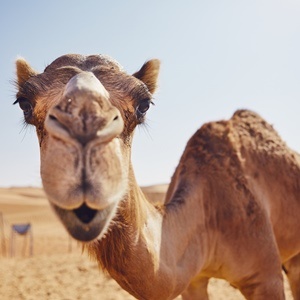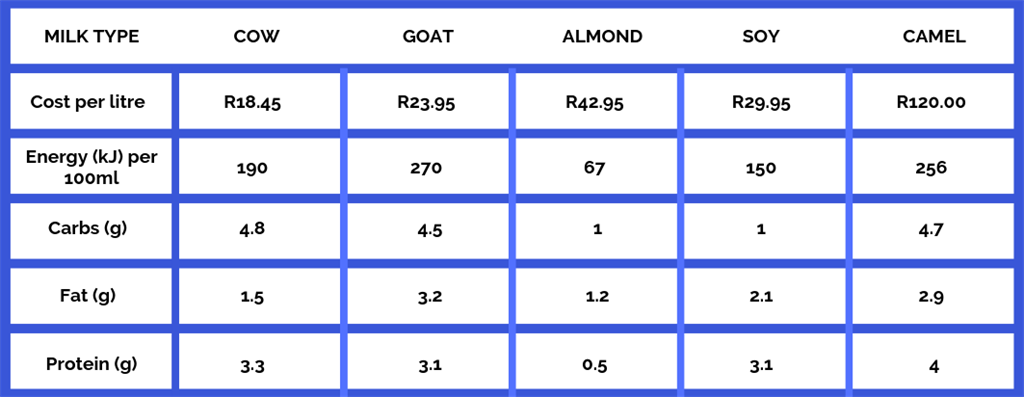
In some parts of the world, camel milk is a local specialty. Dubbed the "white gold of the desert", it’s been popular in the Middle East and certain parts of Africa for thousands of years, but has only recently made its way to South Africa. But what makes the milk so unique, compared to other kinds of milk on the shelves?
What does it contain?
Camel milk is highly nutritious and full of proteins and organic compounds with powerful anti-bacterial, antiviral and anti-microbial abilities, Carin Smit, clinical environmental and metal toxicologist told Health24.
“The protein in camel milk is totally different to the protein in cow’s milk. The protein in cow’s milk prunes neurocirculatory in the brain. That’s why when cow’s milk is given to an autistic child, the autism deepens, whereas camel milk does not contain that protein.”
Although most of the evidence on the link between camel milk and autism is anecdotal, there are a few small studies indicating potential therapeutic effects in children with autism.
Smit adds that the milk is also a rich source of insulin as there are 52 units of insulin-like protein in every litre of camel’s milk, making it a potential natural solution for diabetes.
If you have trouble digesting lactose (the natural sugar found in cow’s milk), or have milk allergies, camel milk can make you forget all about your excruciating digestive issues as it is lower in lactose and doesn't contain the protein that causes an allergic reaction to cow's milk.
Camel milk also has five times the amount of vitamin C and ten times more iron than its bovine counterpart, making it ideal for those with anaemia. Besides this, it’s also anti-inflammatory, can help treat skin disorders such as eczema and psoriasis, and can boost immunity.
We asked dietitian and Health24 expert, Ria Catsicas, to compare the nutritional benefits and average price of (long-life) cow’s milk and common milk alternatives.
Why the high cost?
When compared to other kinds of the milk on the shelves, camel milk is considerably more expensive. This is because camels produce only a fraction of what a cow produces, and the fact that demand far outweighs supply.
Where can I find it?
This novelty dairy contender hasn’t yet headed to the refrigerated section of South African supermarkets. It’s currently available fresh, as unpasteurised frozen milk in one litre bottles, and in milk powder form from Camel Milk South Africa. It has recently been released in its pasteurised form in Cape Town, but has yet to roll out to stores across the country.
The milk comes from free-ranging camels in the remote district of Askham in the Kalahari. It's the only camel milk dairy in South Africa and is run by Hans Knoesen, a former banker whose family has been involved with farming for many years.
The camels were once-wild camels that have become adapted to the Kalahari over the past 100 years and have been tamed, Smit tells us. “Once they’ve given birth, they don’t eat anything that is non-organic. They live on 50 Kalahari bushes, so it’s the purest, most ethically-raised milk that you can find in Southern Africa.”
At the moment, the farm has a total of 44 camels that are milked. If you compare that to the fact that there are more than one million milking cows in South Africa, it helps to explain the high cost.
What does it taste like?
Camel milk looks almost identical to cow’s milk. In the video above, we asked people to try camel milk and most of them found it to be sweet and a little salty, but quite creamy. Most of the tasters said it tastes very similar to cow’s milk. Camels eat plants rich in salt, hence the hint of salt.
The raw milk debate
Raw or pasteurised – which is better?
A big concern about camel milk for consumers is that many products are unpasteurised. Nutrition experts caution against drinking unpasteurised camel milk, which, like other kinds of raw milk, can cause food-borne illnesses.
Pasteurisation doesn’t change the milk’s nutrition profile; it only makes it safer to drink. However, Smit explains that the moment you heat the milk above 54 degrees Celsius, it loses its health benefits.
"When you pasteurise milk, you’re heating it to temperatures where nothing remains alive in the milk, so if there were good bacteria, they'd be lost." It's reduced to a sterile form. And although during the pasteurisation process, from heating to bottling, to capping, bacteria still get in, these bacteria are not probiotic, but pathogenic.
This is why milk putrifies (rots) when it’s been pasteurised and doesn’t ferment, explains Smit, and emphasises that the camel milk ferments because of the probiotics. If you intend to use the milk as a wellness advancement, Smit suggests it’s used in its pure form and not heated when added to tea or coffee, for example.
On the question of diseases affecting cattle, Knoesen explained to Health24:
“We test our camels once a year for Brucella and TB. The previous test was done in April 2018. It's a closed herd and we try not to bring new animals into the herd – and if we do, the new camels are tested and kept separate until the test results are known.”
Smit also weighs in:
“Nobody wants salmonella and Brucella, but that’s why all herds that produce the milk are tested by the state vet, and they are tested on a regular basis to see that none of the more serious conditions like brucellosis are passed on to a population of drinkers.
“We also have to understand that camels have a very unique benefit in that they don’t get sick with the diseases that cows get. They don’t get foot-and-mouth disease (FMD); they aren’t affected by tick bites,” she says.
The worst sickness that can affect camels is the Middle Eastern Respiratory Virus (MERS). However, Smit mentions that this happens in the Middle East and that our camels in Southern Africa are not contaminated. If you want to err on the cautious side, it is best to purchase the powdered milk. Although it may not contain all the immunoglobulins that confer health and immunity, you will have peace of mind, says Smit.
The verdict
The main body of research about camel milk was initially published in Arabic, so very few people in the West knew about it and its efficacy. Although subsequent additional research looks promising, more studies are needed to ascertain its nutritional characteristics and for the camel milk sector to flourish in Southern Africa.
But one thing is certain: the camel milk hype is real and this unorthodox milk product is surging in popularity. According to market research firm Technavio, camel milk consumption is projected to grow by 7% globally each year for the next five years. People are embracing healthier foods and are turning away from industrial cow’s milk for several reasons, which means that camel milk might become a popular health fad in South Africa sooner than we think.
Image: iStock




 Publications
Publications
 Partners
Partners
















